
|
Expedition Chronology I. Preparations |

|
n the grandest scale I've been preparing for years, acquiring skills and experience that are
assumed present
and accounted for: Mount McKinley is not the place to be learning these items
for the very first time!
Examples include, yet are not limited to the following items.
In addition one must be in very good aerobic physical condition. It is likely true that one cannot be in "too good physical condition" for this mountain.
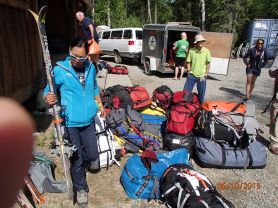
|
|
Plenty of gear for climbing the North American highpoint. (DC) |
On this, a guided expedition, the latter two items were not particularly essential as butterfly knots for roping-in and sled rigging were the guide's responsibility. (Perhaps a more common knot for this purpose is the "Figure Eight on a Bight"). I did not know this in advance, and feel that the time spent at home was not a waste since future unguided trips to other glaciated peaks are nearly a given. Rigging one's self, pack and sled on the lower glacier requires a "Ph.D. in ropology" ... it is a bit complicated!
Surely it is an asset that fully four of six clients have climbed Aconcagua, highest peak in the Andes and fully one half vertical mile higher. Such high altitude experience, although desirable, is not essential for Mount McKinley because one climbs so slowly that altitude-related illness is seldom an issue. However there is a certain psychological benefit to having already been on a (single) mountain for multiple weeks.
I climbed Aconcagua in January 2006 with two friends, unguided, using the normal route. It has the superior objective statistics (higher elevation, more net elevation gain, more distance on-foot). However Mount McKinley is harder.

|
| Emoticon artwork from my mother - it's nice to have family encouragement! |

|
n an intermediate scale is the multi-month process of preparing specifically for the expedition. This usually begins with deciding whether to hire a commercial guide company - and whether one is ready to give it a go in the first place. I have tried without success to organize a private climb. It is very difficult in most cases, and especially mine, as all peakbagging friends who have wanted to climb Mount McKinley had already done such; and all who have never climbed it have no intention of ever going there.
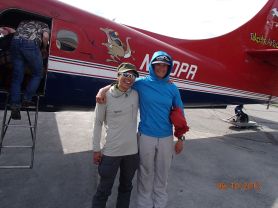
|
|
Lead guide Caitlin at viewer's right and second guide Yoshiko. (DC) |
This leaves me with no recourse but to hire a guide company or climb solo - and the latter is clearly insane. The obvious advantages of "going guided" include a wealth of experience and know-how, a significant safety margin, and all the group gear required - 4-season tents, snow pickets, shovels, snow saws, winterized stoves. Very few individuals own all of these items. The expense and headache of getting them to Alaska is also considered.
The overriding disadvantage is cost. Guided Denali expeditions are very expensive. As of 2013 a standard fee is $7,000. For the current "highly supported" team it is a whopping $11,000. Worse still, the entire amount is due several months in advance. It's like buying a car with cash four months before getting behind the wheel. I don't know of any other major purchase with such an issue - one that leaves me with no funds for climbing peaks all Spring. Instead I camp on the snow close to home, reclimbing the same Cuyamaca Peak again and again.
Farmers and sponsers of outdoor public events purchase weather insurance, hedging against crop failure by paying up-front for that eventuality.
The failure rate at Mount McKinley is nearly 50%. It seems fair and reasonable to charge clients a correspondingly larger fee with successful expeditions (summit), and a refund for failures (turnaround). The exact cash amounts would be determined in such a manner that the long-term company profit be identical to what they would have earned by charging everybody the same amount.

|
|
Aerial view up the Kahiltna Glacier takes-in much of the lower route. (DC) |
Such a plan would have fascinating consequences. A client could reach the summit ridge and turn back mere steps from the top to secure a complete refund. Or he could boldly stride forward for an extra $20,000. YIKES! Somehow I don't think this proposal will be well received .... The solution would be to provide refunds only for failures that have nothing to do with client performance. As on all big mountains weather becomes the overwhelming cause.

|
hysical training occupies the bulk of one's preparations in this intermediate timeframe. Aerobic activity is paramount, simulating the level of exertion required on the mountain itself. Sometimes this gets a bit extreme. In Spring 2011 I carried a 56 pound pack with 15 pounds of ankle weights up and down the concrete sidewalks of my neighborhood. Add trekking poles. Then add a truck tire, dragged along the ground with an iron chain link connecting it to my pack. Uphill, of course.
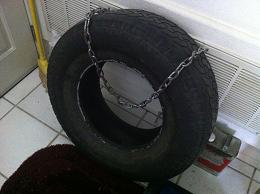
|
|
Pickup truck tire with iron link chain. Note also broom and gasoline tin. (Mouse-click image for detail.) |
The combination provided superb aerobic training. Sadly it also created a minor stress fracture in my right lower limb that returned with a vengeance on the climb itself, suggesting an early retreat. The possibility of such an orthopedic injury, walking on unforgiving concrete, was always in the back of my mind.
(Incidentally: after about two dozen such sessions, always at night to minimize prying eyes, friction with the ground broke my iron chain. The heat generated was tremendous. Perhaps I should have drilled two holes in the rubber, such that no chain would ever have to contact ground.)
Did I have a choice in how to proceed?
Yes I did. A few years ago some neighbor summarily left an elliptical trainer next to the dumpster - and I dragged it indoors, at great effort, to become my preferred device every other evening as replacement for the unforgiving concrete which surely was bad for my knees as well.
The mechanics were fine. The electronic programs were nonfunctional. That's OK - I just used this bicycle with a heavy pack and ankle weights (to simulate plastic boots on snow) for at least one hour at an ever-increasing speed. Television commercials, even more puerile and infantile than the programs they interrupt, are opportunities for "maxing-out" my rate - all the while sweating so heavily that I use a pair of longjohns as a bandana.
My tee-shirt drips with sweat afterwards. Trousers are too much - I wear only underwear - and they take 3 days to dry so multiple pairs are rotated.
I continue this regimen even now. However without the ankle weights.
Knots are reviewed, and crevasse rescue simulated in my living room using chair legs as "snow anchors", a 30 meter rope, my elliptical trainer's rear wheel as "victim" - and nearly a dozen carabiners tying it all-together. The Z-pulley system which provides a 3:1 mechanical advantage.
I make a science out of winter camping, thrice in the colder months with as many trips to Cuyamaca Peak, and then in Nevada on a two week climbing trip with a simulation of all morning tent-bound preparations as if I were on the Kahiltna Glacier. I learn how to dress while still in my sleeping bag.
I am certain every Mount McKinley climber has a unique training regimen. Somebody with no physical conditioning might have to begin fully one year in advance. They would find progress initially rapid, thence the rate tapering-off with additional increments of fitness level becoming increasingly difficult to secure.

|
he final preparation phase comes with actually flying to Alaska and meeting all participants. I make airline reservations for one day earlier than required to hedge against lost luggage, cancelled flights, whatever. Never before have I taken such a precaution - yet with $11,000 on the line it seems prudent.
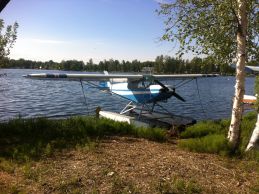
|
|
The world's busiest floatplane hub is right next to the Millennium Hotel. |
One week before travel I learn President Obama will be in Los Angeles, my originating city. His schedule would include landing at LAX just when I'd be driving north through the area, followed by lunch at a Democratic fund-raiser in nearby Santa Monica. I alter driving plans from San Diego, choosing Interstate-5 through downtown Los Angeles rather than I-405 which goes right by LAX. Then, after lunch with my parents in Encino, I take a shuttle bus south from Van Nuys, where my pickup truck is parked for the duration, to the airport.
The Millennium Hotel is selected for clients. It's quite expensive. Both my roommate Jean François Jenck and I agree that paying $210 for an overheated room worth half that amount was a poor choice indeed. I sleep atop the bed covers, no shirt. This is ridiculous - and the room's thermostat cannot be manipulated. Opening the window helps a little.
Jean has just arrived from France, and comes one day early to begin adjustment to the new time zone. Each evening I leave the room as he sleeps. It's a minor inconvenience.
One highlight of this period is meeting the entire team for dinner at a fancy restaurant - the Crow's Nest atop the Captain Cook Hotel in downtown Anchorage. It's Jonathan Sugarman's concept, and upon learning of it immediately sign-on because I am very much into gourmet food. He is a physician living in the Seattle area.
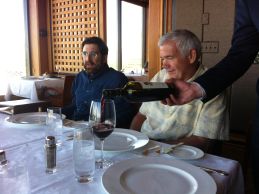
|
|
Wine at the Crow's Nest. Jonathan at viewer's left, Nick K. at right. |
Attendees include the remaining clients - Dave Colley, Mike Theologos and Nick Klaich.
Rack of elk with a cherry glaze is my entrée. Later on dessert is a spectacularly presented dish of fried banana with ice cream, caramel sauce and berries. It's an architectural masterpiece.
The expedition proper begins next morning at 10 a.m. Fully six guides and six clients sit in a corner room and make introductions. Lead guide is Caitlin Hague with some 12 Mount McKinley expeditions. The hierarchy continues with Yoshiko, Nickel, Dan, Zack and James. Every person has a specific role. Terrible at names, by the expedition's end I nonetheless finally can match them with faces 8-).
There is a critical gear check in the room, every article of clothing, and much much more, scrutinized and discussed. We want to bring enough - yet not overkill because of weight. Then we attend Alaska Mountaineering and Hiking to make good any perceived shortfall.
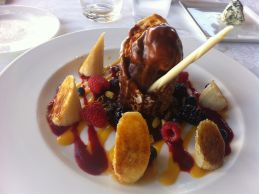
|
|
The author's dessert is visually striking and to-die-for delicious. Leftover roquefort at upper right. |
Lunch is at the Bear Tooth Grill. As life is short I order dessert first, a hearty serving of brownie with plenty of vanilla ice cream and chocolate fudge sauce. My one pound salmon burrito is almost an afterthought after such a treat. Many default to pizza.
Back at the hotel snack food is selected - everything consumed apart from group breakfasts and dinners. The variety of savory and sweet items is substantial. I am pleased, especially with dried salmon and certain chocolate-covered blueberries. Again, a compromise must be reached between having enough calories and carrying simply excess weight. Guidelines are followed.

|
|
New-age chocolate blueberries loaded with antioxidants! |
The next morning we congregate at 8 a.m. and take a company van north to Talkeetna. We stop in Wasilla for lunch food that's to be eaten on-the-go at some point today. At a well-stocked supermarket I choose Spanish manchego cheese, a French baguette, and an assortment of fancy olives. Others purchase a large sandwich apiece.
We attend the mandatory National Park Service orientation, including a film graphically portraying some of the possible injuries and accidents Mount McKinley climbers could face. To verify our permits and to pay park entrance fees a ranger asks,
"Who are the clients?"
to which Mike Theologos replies,
"Just look for the grandfathers."
His humor, usually at mealtime, was often appreciated.
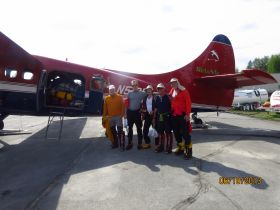
|
|
From viewer's left - Jean, David, Adam, Mike and Nick. (MT photo) |
Our flights onto the glacier are scheduled for 5 p.m. However the weather forecast calls for deteriorating conditions by evening (whatever THAT means when there's no true darkness). Caitlin tries unsuccessfully to move forward our flights.
Three free hours (why the "eat on the go concept"??) suggests strolling through tiny "downtown" Talkeetna. Soon enough I am bored, although the conversation with Jean François and guide Dan Sidles is certainly enjoyable. By 4 p.m. I am changing clothes in preparation for the glacier.
A pair of aircraft are needed to haul us 12 and what must be over one thousand pounds of material onto the Kahiltna Glacier. We are careful to verify that each person's gear, including clothing and sleeping bag, goes on the same plane: if one of them turns back on account of weather nobody is left stranded at camp without these essential items.
The flight's scenery is superlatively beautiful. It is, arguably, the most visually striking component of the entire experience as we fly between mountaintops, through aptly-named One Shot Pass, and then descend onto the Kahiltna Glacier's southeast fork.
| previous page - Introduction | next page - Lower Mountain |